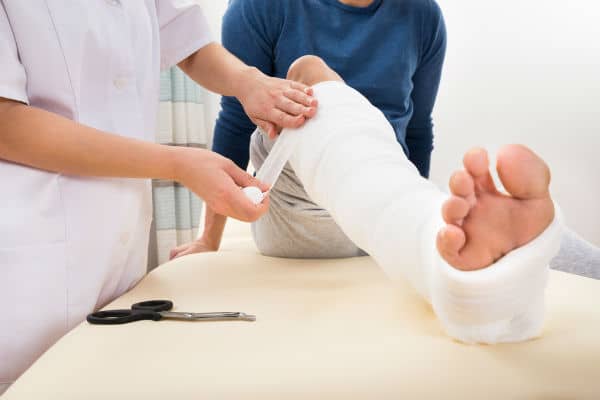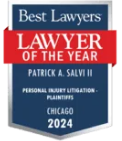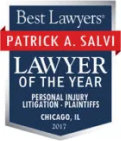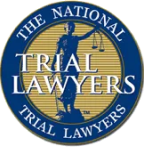
Broken Bones and Fractures in Car Accidents
Broken bones are some of the most common injuries that result from car crashes – and some of the most devastating. Victims often face costly medical care and ongoing mobility issues that affect their ability to earn a living and enjoy their lives. If you suffered bone fractures in a car accident someone else caused, you should not have to deal with these problems alone. Instead, you can contact Salvi, Schostok & Pritchard P.C. to speak with an experienced car accident lawyer in Chicago about demanding fair compensation for what you’ve suffered.
Why It’s Important to Work with a Lawyer Experienced in Broken Bone Cases
Did you suffer broken bone injuries in a car accident someone else caused? If so, they might owe you money for what you’ve suffered – but getting this compensation can be difficult. That’s because you’ll probably have to go through their insurance provider to get it. The insurance company’s adjusters and defense attorneys might argue that you were somehow to blame for the accident, that your car accident injuries aren’t as serious as you claim, and that you won’t get a better offer than the one they’re pressing you to accept. Don’t believe what they say.
Instead, turn to a Chicago car accident attorney for help leveling the playing field. The team at Salvi, Schostok & Pritchard P.C. has spent more than 40 years protecting clients like you and has recovered more than $2.5 billion on their behalf. We know how debilitating broken bones from a car accident can be, and we firmly believe the person who caused them should have to pay for the consequences. We’re so committed to that we’ll work on your case at no upfront cost to you, taking on all the risk and getting paid only if we deliver the results you deserve.
Here are some of the significant results we’ve achieved for our clients who suffered severe fractures like you:
- A $20 million settlement for a man? woman? who was it? who suffered ankle fractures and other serious injuries after being hit by a CTA bus
- A $20 million settlement for a young mother who suffered thoracic spine fractures to her 3rd and 4th vertebrae after being T-boned in Maywood
- A $10.8 million partial settlement for a man who suffered severe spine damage when he was hit by a driver as he walked to the train station in Lake Forest
- A $3.7 million verdict for a man who suffered an ulnar fracture when he was hit by a construction worker in Mokena
Why Do Bones Break in Car Accidents?
A bone breaks in a car accident because these collisions exert amounts of pressure so tremendous on the human body, the force can break even the strongest bones. When a vehicle crashes, the body may be thrown about the vehicle. Some fractures occur when the victim hits the steering wheel or another hard surface in the vehicle. Passengers can suffer a broken leg if their leg hits the dashboard or the seat in front of them. Human bones are no match to the force exerted by a 4,000-pound vehicle traveling at even moderate speeds.
Common Bone Fractures from Car Accidents
There are various types of bone fractures, which depend on the type of break, the location of the break, and the severity. Common fractures in car accidents include:
- Compound fractures
- Oblique fractures
- Spiral fractures
- Stress fractures
- Comminuted fractures
- Buckle fractures
- Transverse fractures
- Avulsion fractures
- Hairline fractures
- Compression fractures
The human body is made up of 206 bones, any of which can break in a car wreck. The most common broken bones in car crashes include:
- Femur fractures
- Hip fractures
- Clavicle fractures
- Rib fractures
- Wrist fractures
- Severe skull fractures
- Facial fractures
- Pelvic fractures
- Ankle fractures
- Spinal fractures
- Arm fractures
If you suffered any type of broken bone in a car crash, contact our caring team for immediate legal assistance.
Causes and Consequences of Broken Bones in Car Accidents
Acute and blunt force trauma are the ultimate causes of many broken bones in car accidents. These injuries can have a serious effect on a victim’s life, including:
- Nerve Damage – Snapping bone can damage nerves, in turn preventing the body from sending impulses to and from muscles and organs. Some cases of nerve damage take weeks or months to heal, while others last for a lifetime.
- Joint Issues – When a bone fractures, the injury can impact the adjacent muscles, ligaments, and joints. This can lead to osteoarthritis and other joint problems, causing pain and limiting mobility.
- Loss of Strength – Patients with a bone fracture often notice decreased strength in the affected appendage or joint. This deficit might improve with rehabilitation.
- Inability to Perform Tasks – Patients often find routine tasks difficult, such as brushing their hair, reaching for an object, cooking, or picking up heavier objects.
- Depression and Anxiety – The cumulative effect of these issues can also lead to depression over reduced abilities and ongoing pain.
In addition to these general consequences, broken bones can also have serious medical complications, such as:
- Infections – Traumatic injuries like broken bones in car accidents can allow bacteria to enter the fracture site. The bacteria could result in osteomyelitis or other bone infections. One particularly common infection is tetanus. Usually, doctors irrigate the wound with an antibacterial solution and give oral or IV antibiotics.
- Deformities – If the bone does not heal properly, malalignment can lead to a deformity that impairs movement.
- Arterial Damage – Bone fragments can nick an artery, which can prove life-threatening even if immediately treated.
- Fat Embolism – Small microparticles of fat enter the bloodstream and can cause circulation blockages that can lead to death.
Diagnosis and Treatment of Broken Bones Following a Car Accident
Diagnosing broken bones is usually completed by using an X-ray. MRIs and CT scans help when a broken bone is slight, such as a hairline fracture.
Medical treatment for car accident fractures varies according to the location and nature of the fracture. Standard methods of care are:
- Casts or Immobilizers – These hold the bone together to encourage the natural fusing process. Casts are usually on for six to eight weeks with follow-up X-rays.
- Closed Reduction – Doctors align the bones by manipulating the body without cutting it open. Reduction requires anesthesia or sedatives. Afterward, a cast is applied.
- Open reduction – Some victims who suffer fractures may require surgical repair. During this surgical procedure, a doctor cuts into the flesh to align the bones and put them back in place. Metal rods or plates are inserted into the bone to hold it together.
- External fixation – Here, the surgeon puts screws into the bone and attaches them to a metal plate or rod outside the body.
The recovery process varies for each patient, depending on their age, health, and bone break. Some patients are put on bed rest to prevent any further damage.
Possible Compensation for Fractured Bones in Car Accidents
If someone else is responsible for your broken bones, a car accident attorney in Chicago can help you demand they compensate you for your:
- Medical expenses and rehabilitation, along with continuing physical therapy
- Home modification to help with long-term disability
- Lost wages
- Reduced earning potential
- Pain and suffering
Contact Our Chicago Car Accident Lawyers for Help
Are you ready to pursue justice and accountability for the broken bones you suffered in a car accident someone else caused? Contact Salvi, Schostok & Pritchard P.C. today and ask for a free consultation with an experienced Chicago car accident lawyer.







